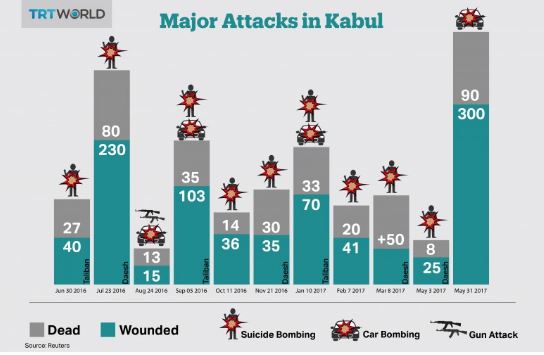Source: TRT WORLD/
Another explosion struck the heart of Kabul, the capital of Afghanistan on Wednesday, killing at least 90 and wounding over 300 people. It was just the latest in a series of attacks on a people that are the victims of seemingly perpetual war.
A few hours after an explosive-filled tanker detonated in Kabul, Afghanistan on Wednesday, the discussion returned to other topics, like US President Donald Trump’s “Covfefe” tweet. So it was business as usual for media, as if violence has become so mundane in Afghanistan that it doesn’t really matter.
The country has been the victim of war as far back as most people’s memories go, blurred into an Asian region that seems to be as homogenous as it is plagued by terrorism.
Such is the nature of collective memory, and the first draft of history to which journalism is witness. For the people of Afghanistan, the reality is more complex.
Generations have experienced their home only as a battleground for others: from British attempts at colonisation to the former Soviet Union’s incursion into the country to prop up a communist government; from the rise of the Taliban after a civil war to the post-911 US-led “War against Terror.”
Following is the historical context to Wednesday’s attack:
1. War in Afghanistan has killed close to two million people since the late 1970s when soldiers from the former USSR occupied major cities in Afghanistan. The country has been at war since.
2. Iran, Pakistan, China, Saudi Arabia and the United States all had a stake in keeping the Russians out of Afghanistan. These countries financially, logistically and ideologically supported various militias, known as the mujahideen, to fight against Soviet forces.
3. The Taliban – concentrated in areas around the porous Pakistan-Afghanistan border – were born out of the very same mujahideen who were funded by the US, Saudi Arabia and helped by Pakistan in the Soviet-Afghan War.
4. One million civilians and about 15,000 Soviet soldiers are estimated to have been killed during the Soviet-Afghan war.
“People are talking about 1.5 million people while others put this number higher. There hasn’t been really concrete documentation of these numbers,” Borhan Osman told TRT World.
Osman, an analyst at the Afghanistan Analyst Network – a non-profit research organisation – said casualties from the Soviet-era conflict were not documented consistently.

5. The power vacuum left by the exit of the Soviet Army and the foreign players in 1989 triggered a civil war. The gap was filled by various militias, among them the Taliban who were backed by Pakistan and inspired by religious teachings exported from the Arab world. Pakistan and Saudi Arabia were the first to recognise the Taliban government in 1996.
6. 6,339,095 Afghans had been displaced internally or had become refugees by 1990. At least 2.7 million are still living as refugees.

7. The United States re-entered the fray in 2001 after the 9/11 attacks, looking to “smoke Osama bin Laden out” of Afghanistan, where the Taliban were allegedly sheltering him. That war killed over 30,000 civilians between 2001 and 2016, according to one study. Afghan military and police casualties were another 30,000 plus. These are conservative estimates.
8. During the Soviet-Afghan War, the US equipped the mujahideen with anti-aircraft missiles, spending about $3 billion in military and economic assistance.The second incursion into Afghanistan has been heavy on the US pocket – it spent $1.07 trillion from 2001 to 2014. Money spent directly on the war reached $783 billion by 2016.
9. Troops from the US and other NATO countries still remain in Afghanistan – with both Germany and the US considering an increase in boots on the ground. But the Taliban continue to operate with relative impunity in many parts of the country.
Osman believes that sending more troops into Afghanistan is not the answer. Neither does Aimal Faizi, a journalist and former spokesperson of former president Hamid Karzai.
“Afghan experience shows that foreign troops, no matter in what number, cannot be the solution to the foreign imposed war in Afghanistan,” Faizi said.

10. Afghanistan and the US administration of President Barack Obama signed a bilateral security agreement to allow American troops to stay in the country beyond 2014. The deal is unpopular with many Afghans who see it as more meddling by one of the countries that have been a source of so much of their misery.
11. In 2015, regional terrorist group Daesh started making inroads into Afghanistan, targeting the government, civilians, and competing with the Taliban.
12. Daesh has made its presence in the northern and southern provinces and has already carried out attacks.


